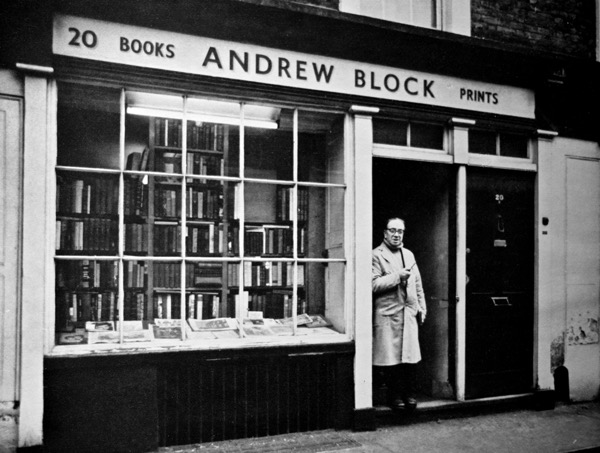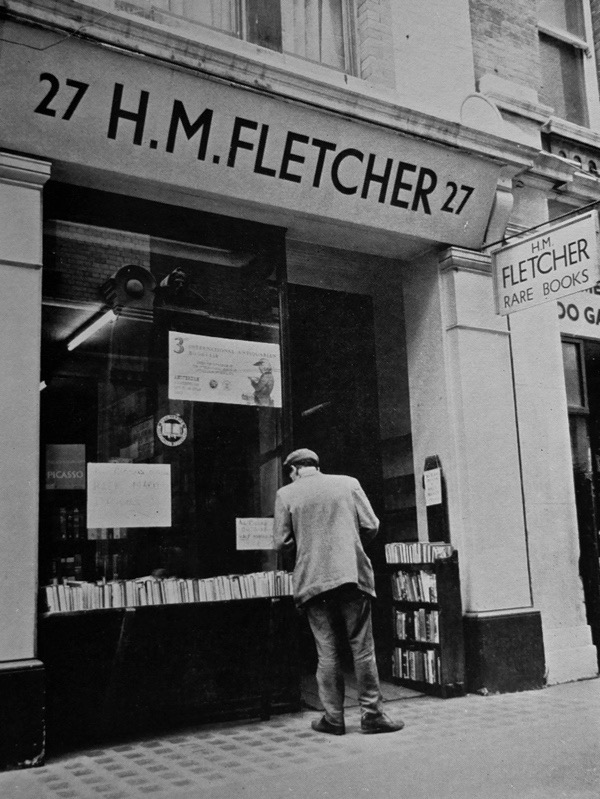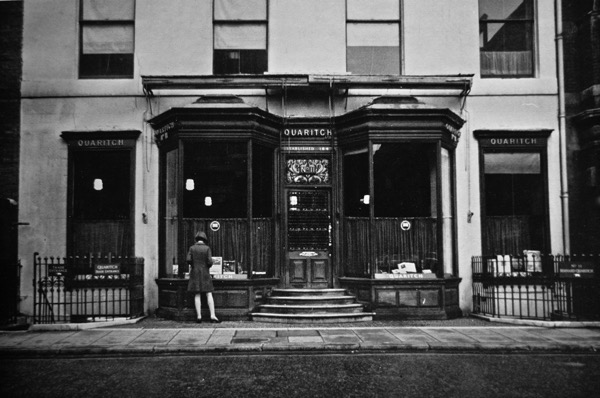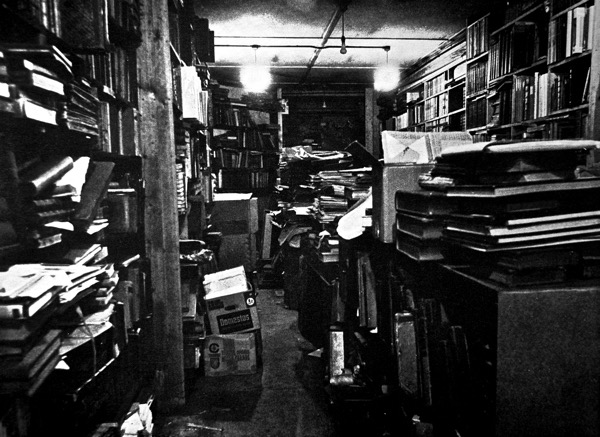Welcome to The Last Bookstore is a short, inspiring documentary about Josh Spencer, owner and operator of The Last Bookstore in downtown Los Angeles:
Comments closedTag: used-books
The Antiquarian Bookshops of Old London

At the lovely Spitalfields Life blog, the Gentle Author reminisces about buying and selling used books in London, and shares some wondeful black and white photographs of the city’s secondhand bookshops taken in 1971 by Richard Brown:
Frustrated by my pitiful lack of income, it was not long before I began carrying boxes of my textbooks to bookshops in the Charing Cross Rd and swapping them for a few banknotes that would give me a night at the theatre or some other treat. I recall the wrench of guilt when I first sold books off my shelves but I found I was more than compensated by the joy of the experiences that were granted to me in exchange.
Inevitably, I soon began acquiring more books that I discovered in these shops and, on occasion, making deals that gave me a little cash and a single volume from the shelves in return for a box of my own books. In this way, I obtained some early Hogarth Press titles and a first edition of To The Lighthouse with a sticker in the back revealing that it had been bought new at Shakespeare & Co in Paris. How I would like to have been there in 1927 to make that purchase myself.





Comments closed
How The Strand Keeps Standing

Over at New York Magazine, Christopher Bonanos (author of Instant: The Story of Polaroid amongst other things), profiles New York new and used bookstore The Strand:
Comments closedWhen you visit Amazon or AbeBooks (which is owned by Amazon) and search for an out-of-print title, your results are usually listed from cheapest to most expensive. The first “store” on the list often turns out to be a barn full of books in rural Minnesota or Vermont. Some are charity stores, selling donated books—no acquisition costs at all. They certainly aren’t paying Manhattan overhead. Yet here, too, the Strand is holding on, owing mostly to that churning turnover and the quality of its stock. That barn isn’t going to have many of last year’s $75 art books for $40, and the Strand always does. Plus there are the only–in–New York surprises that come through the store’s front door. Opening a box can reveal a Warhol monograph that will sell for more than $1,000, or an editor’s library full of warm inscriptions from authors… Surely operating out of one of those barns would be cheaper. “Not with our formula,” says [owner Fred] Bass firmly. “We need the store. This business requires a lot of cash flow to operate,” and much of it comes in with the tourists. That funds the book-buying, which supplies the next cycle of inventory. Which requires this expensive retail space, and the renovation of 2003 did not just come from a desire to spiff up. It happened because of a specific event, one that probably saved the Strand: In 1996, after four decades of renting, the Basses bought the building.
Something for the Weekend
Comics Without Borders — a long interview with cartoonist Joost Swarte at The Comics Journal:
In the graphic field of comics I was inspired by Will Eisner’s Spirit. If I see these title pages, the constructions in his title pages, and what he does with the lettering, that was very interesting. And then another thing is, I love the older comics like Little Nemo and Lyonel Feininger. And I was interested also, because I studied industrial design… about the Dada people in Holland and Germany, and Bauhaus architecture and design world, in which there are almost no borders. I mean, people do whatever they like. Then you have the older artists like Tatlin. They designed their own clothes, they do architecture, they do flying machines, they do painting, they do everything. I mean, it was always nice to know that if you want to do different things, that you’re not standing alone. That somebody else did it, and they survived.
Losing Their Grip — Peter Aspen reviews three new books on cinema — The Big Screen by David Thomson, Do the Movies Have a Future? by David Denby, and Film After Film by J Hoberman — for the FT:
It is one of the most famous one-liners in the history of cinema, which also turned out to be an inadvertent prophecy. “I am big,” says the slighted Norma Desmond in Sunset Boulevard (1950). “It’s the pictures that got small.”
She had no idea. The past half-century has seen the pictures get smaller and smaller, to the point that we wonder if they can ever be big again. From television screen, to laptop, to smartphone, the ever-shrinking movies reach a greater part of the world than ever before. But what have we lost along the way?
Holberman’s book is given more in-depth consideration at the LA Review of Books.
And finally…
In the shit — book shopping with Michael Dirda at The Paris Review:
So this is how a man acquires 10,000-odd books, more than he could ever display or read. It’s a combination of maniacal persistence and utter nostalgic whimsy. You have to be willing to search high and low for a potential beauty, but most of the time you’ll take a Book Club hardcover of a book you don’t like if it reminds you of something from your past.
As if to illustrate the point, Dirda found a mass-market paperback of Black Alice, by Thomas Disch and John Sladek. Dirda was a friend of Disch until the sci-fi author killed himself in 2008. “He was a wonderfully cynical man,” Dirda said. “I have a first edition of this but I’ll get it anyway.”
Comments closed
Midweek Miscellany
Designer Jon Gray (AKA Gray318) has launched a new website.
Jon has also been interviewed by We Love This Book:
A book cover only becomes iconic because the book that it covers becomes iconic. The cover is just a face for the content. I have been lucky to work on some really great books and have benefitted from their success. People often assume that by copying the cover of a successful book it will help their book sell, and are always surprised when it doesn’t work. It always has to start with the content.
The Browser — Author Anthony Daniels on the digital challenges faced by books, at The New Criterion:
An intellectual might be defined as someone who elaborates justifications for his own tastes and preferences, as metaphysics was once defined as the finding of bad reasons for what we all believe on instinct. And so the reader of books soon finds reasons for the supposed superiority of the printed page over the screen of the electronic device: for nothing stimulates the brain quite like the need for rationalization. The dullest of minds, I have found, works at the speed of light when a rationalization is needed…
Whether the book survives or not, I am firmly of the opinion that it ought to survive, and nothing will convince me otherwise. The heart has its beliefs that evidence knows not of. For me, to browse in a bookshop, especially a second-hand one, will forever be superior to browsing on the internet precisely because chance plays a much larger part in it. There are few greater delights than entirely by chance to come across something not only fascinating in itself, but that establishes a quite unexpected connection with something else. The imagination is stimulated in a way that the more logical connections of the Internet cannot match; the Internet will make people literal-minded.
And finally…
As am I, as am I — Edward Docx on the Sherlock Holmes ‘pilgrims’ and a re-enactment of The Final Problem organised by The Sherlock Holmes Society of London:
Comments closedI have come to like the pilgrims a good deal. They’re warm-hearted, engaging and amusing people, which is more than can be said for the moped brethren. There are many from the legal profession—Moriarty is a practising barrister; Cardinal Tosca and Queen Victoria (who are married) are retired from the bar. Sherlock Holmes, I learn, is an ex-head teacher—and is (disconcertingly) married to Mrs Hudson. Watson works for Lloyd’s of London. The strangest and most impressive folk are those who have come the furthest—not least the two ladies from the aforementioned Japan Sherlock Holmes Club (founded in 1977; about 1000 members), who do not, I think, speak English and who are posing as “Baritsu Assistants”—this being some kind of martial art that Holmes knew and that saved him in his struggle with Moriarty on the falls. There are also policemen, toxicologists, bookmakers, engineers, historians, and many who—nobly—refuse to admit to any other existence save that of their character. If these people have anything in common, beyond the obvious, it is that they are all comfortable with a very elastic sense of reality… As am I, as am I.
The Book Monger
A charming interview with Patrick Kelly, the owner of a second-hand bookshop in Brixton called Book Mongers. The shop celebrated its 20 year anniversary in May:
(via Simon Armstrong)
Comments closedSomething for the Weekend

Imprint talks to John Bertram about his Recovering Lolita project:
For obvious reasons, of course, [Lolita] remains as controversial a novel as it was a half century ago, if not more so. And, probably helped along by Kubrick’s breezy film, and many very terrible covers, the term “Lolita” has come to popularly mean something quite the opposite of the novel’s namesake, so a designer has that to contend with as well. On the one hand, then, designers face the very real challenge of communicating some of that complexity in a cover, which can easily become overwhelming… On the other hand, I think there are also important ethical considerations that require careful negotiation since, whatever people may think, we are talking about a novel which has child rape at its core.
There is more about the project here (pictured above: Lolita designed by Rachel Berger).
The Bare Specificities — A really lovely profile of Portland-based book-scout Wayne Pernu at The New Yorker:
On the job, Pernu keeps a few principles in mind—first and foremost, the importance of condition. For example, with its original dust jacket, the value of a first-edition “The Great Gatsby” can multiply from two thousand five hundred dollars to more than two hundred thousand. “That little piece of paper on the book is often worth thousands and thousands of dollars, much more than the book itself,” Pernu says. “Specificity is really crucial as well. A book called ‘World History’ isn’t going to do well, but a book called ‘Peruvian Shovel Makers in the Seventeenth Century,’ that’s going to be worth a lot of money to someone. You always get excited when you see something that specific, no matter what it is.”
Also really nice: An interview with English letter carver Fergus Wessel for I Love Typography:
Eric Gill is my hero! His lettering, in my opinion, remains unsurpassed, partly because of its honesty. We are all striving for perfection, but there really is no such thing of course. If we try to control it and attempt to be too artistic, we are in danger of losing that honesty. One has to let the letters flow a little.
There are certainly strict rules of good layout and lettering, but rules are there to be broken. But in order to bend the rules, one has to know them in the first place, and attain that initial discipline. This requires years of experience and practice; it is something that evolves and it is during this evolution that you develop your own individual style and form.
And finally…
Alexandra Harris, author of Romantic Moderns, on Modernism at The Browser:
Comments closedTo an extent, yes. But take [Nikolaus] Pevsner for example, who was one of the great exponents of the Bauhaus version of modernism in England. Because there’s such a strong German tradition of minimal, pared down, internationalist architecture, for him it was a kind of nostalgia. It wasn’t our English tradition but a German tradition, so it seemed to us very brutal and modernist. But to him it was laden with associations and emotions, as it was for the other émigré artists like [Laszlo] Maholy-Nagy and Naum Gabo.
Again, what seems very new is actually attached to a tradition, and is so much more interesting that an absolute break with the past. A lot of these buildings that seem very modern are deeply entangled with a tradition of classical architecture using the same classical symmetries and the sense of elegance and refinement that comes straight down from Greece and Rome, and it doesn’t get more traditional than that. So there’s always a traditionalism in the modern.
The Wave Pictures, Sweetheart
The official video for The Wave Pictures EP Sweetheart, directed by Ben Reed and made entirely out of second hand books:
2 CommentsMidweek Miscellany
 Michael Cho‘s cover for the Best American Comics annual 2010 published by Houghton Mifflin Harcourt. Fantastic.
Michael Cho‘s cover for the Best American Comics annual 2010 published by Houghton Mifflin Harcourt. Fantastic.
Undefined — The Caustic Cover Critic interviews illustrator and designer Alice Smith:
After sketching ideas, I make compositions using inks and pens to bring collages together, the pen marks might have disappeared in the finished composition, but it’s the pen marks and the rough sketch that helps bring it together. I use old imagery for ethereal effect, playing with visual alchemy and nostalgia. And the quality of printing pre 1950s, photoengravre and proper litho is so much nicer than the pixel fuzz and dots of newer digital printing.
Alice’s portfolio is here.
Scraps of Paper — An interview with superstar designer Rodrigo Corral in Metropolis magazine:
[T]he parts of the process that are unique and special really come from the individual designer’s experience. I think about the people who might read this article, and assuming some will be design students or younger people just getting into book design, I have to say that in order to come up with ideas—which, aside from a solid understanding of typography and typographical context is the most important part of all of this—you have to have an understanding of what has come before and what is current. I’ve spent years in used bookstores and magazine shops looking, admiring, and collecting, and this is all a part of the “design process.” The things I have stored in my brain and all that is still out there to see and learn are all part of the process.
Bought and Discarded — Simon Akam explores the sidewalk booksellers of New York for More Intelligent Life:
What wasn’t clear was what it meant to have a big presence on secondhand stalls. Was it an honour for a book, or a slur on its author’s reputation? Which was more significant—the fact that so many copies had been bought by someone, or the fact that they had since been offloaded again? To add insult to injury, were the titles I encountered in droves lying on the stalls because today’s reading public chose not to pick them up, even at a much reduced price? I needed to find out whether the champions of my survey were much loved, or doubly scorned.
And finally…
 The Road: Scenes From the Post-Print Apocalypse by Peter Kuper for the New York Times (via The Ephemerist).
The Road: Scenes From the Post-Print Apocalypse by Peter Kuper for the New York Times (via The Ephemerist).
Something for the Weekend, Feb 27th, 2009
The 5 Rules of Book Cover Design Book — John Gall, VP and art Director at Vintage, talks about designing books at Barnes & Noble (video). There is also a nice print interview with John Gall from 2007 at STEP Inside Design magazine and another interview with the designer from the same year at fwis Covers website (which is worth it just for the immortal line: “I want a telepathic dog.”) (John Gall at the Book Cover Archive— Pragmatism: A Reader designed by John Gall, pictured above)
Fear, panic, and a little bit of hope — Sarah Weinman discusses the perilous state of the publishing industry on NHPR’s Word of Mouth.
Chapters-Indigo‘s move into e-books, Shortcovers, goes live to much curiousity and twittering. The Globe and Mail has the basics, The National Post’s The Ampersand rounds up some of the reactions, but O’Reilly’s TOC seems to sum up the general mood: “A Good Start, But Room for Reader Improvement”. Michael Serbinis, the executive VP, writes about the first day on the Shortcovers blog.
(NB – I’ve sort of been ignoring the Kindle2 stuff as it’s not available in Canada, but — just to have some balance — E-Reads has a nice round up of the coverage).
Influence the future — Anthro Goggles lists the first 4 SF books you should read if you work in social media.
Jacket Copy — An interesting interview with David L. Ulin, book editor of the Los Angeles Times (who folded their standalone book section 6-months ago), in PW:
Ulin takes a realistic, broad-ranging view of how book coverage will be presented in the future. “I’m committed to both print and Web. There are two readerships, and I’m not sure they’re the same. My main interest is, how do we get the most book coverage to the most people?” Ideally, Ulin would welcome a return to the stand-alone book review. “But we don’t have one now, and we’re not going to have one,” he says.
modernism 101 : from aalto to zwart — “We specialize in rare and out-of-print design books and periodicals. Our carefully-selected online inventory spotlights both famous and forgotten modernist architects, photographers, typographers, and industrial designers in all their published glory.” How could I not link to this? Even if you can’t afford the books (which I can’t) you can at least look at the covers! (The Twentieth Century Book by John Lewis pictured above). (via ISO150)
And on a related bookporn note, Grain Edit has some rather nice pictures of Typographica, the design journal edited by Herman Spencer…
Comments closedMidweek Miscellany, Feb 25th, 2009
“Facts are stranger than fiction” — The Toronto Star profiles The Monkey’s Paw bookshop and owner (pictured):
“Books have been totally superseded by digital. A generation ago, books were not only the primary, but the only way we stored and transmitted culture. Books were culture. And they’re not any more. They’re these odd anachronisms,” Fowler says. “But that doesn’t mean they don’t contain all sorts of treasures. They’re beautiful and interesting and they have fascinating content and startling stuff in them.”
The serendipity of accidental discovery — Allison Arieff profiles William Stout, publisher and owner of the eponymous architecture and design bookstore in San Francisco, for the New York Times:
I love the tangents an afternoon spent searching the Internet can generate… But I realize as well that it’s contributing to a sort of collective ADD that makes ambling through aisles of a place like Stout Books feel that much more special, requiring an altogether different commitment of time, care and attention.
A Publisher’s Decalogue — 10 (+1) good rules for publishers from Alma Books (via The Book Depository Blog).
The E-Book Difference — The Book Oven’s Hugh McGuire on why publishers need to get to grips with e-books and mobile devices:
The reason digital and ebooks are going to become more important is that’s where the eyeballs are going to be. And if you can’t find more ways to get eyeballs on digital books, then I do fear for the future of (traditional) book publishing.
Making Magic — A sprawling interview with the brilliant (and possibly quite bonkers) Alan Moore in Wired:
I thought that a book like Watchmen would perhaps unlock a lot of potential creativity… I was hoping naively for a great rash of individual comic books that were exploring different storytelling ideas and trying to break new ground… That isn’t really what happened. Instead it seemed that the existence of Watchmen had pretty much doomed the mainstream comic industry
Borderless thinking — Graham Vickers looks at how digital is rewriting the rules for publishers and distributors in The Guardian:
The most creative ideas are still to be found outside the orbit of the traditional media… in places where there were no predefined models, and no pre-existing ground rules to impede borderless thinking.
Daily Routines — A blog about how writers, artists, and other interesting people organize their days. For someone who endlessly struggles with their daily routine, I find this fascinating.
2 CommentsMegalisters
“What fun is there in clicking… compared to the pleasure of handling a fine copy of a rare book?”
Mick Sussman examines used-book selling in the internet age for the New York Times:
[T]he state of the art in used-book selling these days seems to be less about connoisseurship than about database management. With the help of software tools, so-called megalisters stock millions of books and sell tens of thousands a week through Amazon, AbeBooks and other online marketplaces.
But, it’s not all bad news for the small dealer:
“Though the rise of the megalisters has hurt many mom-and-pop operations, the toll has been less than catastrophic. A database maintained by Susan Siegel of Book Hunter Press lists 3,968 “open shops” — as brick-and-mortar outlets are known — across the United States today, down from 4,119 in 2002. A 4 percent drop over six years might not be something to cheer about, but it would seem downright enviable to record or video store owners.”
What are smaller used-book sellers doing to survive? Using their experience, sharing “alchemical trade wisdom” in online forums, focusing on books that are rare–if not exactly collectible–and combining labour-intensive hand-selling with the selective use of e-commerce:
Comments closedAfter the great wave of creative destruction set off by e-commerce, the more adaptable breed of used-book seller seems to have survived… Chris Volk, a store owner and the vice president of the Independent Online Booksellers Association, says her colleagues are frustrated but undaunted by the megalisters. “In the long run,” she said, “people who know what they’re doing will win out.”






